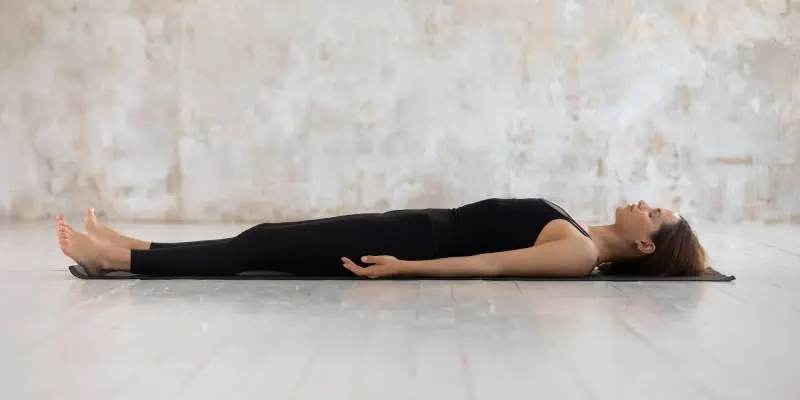Have you ever been in a fast, sweaty, and strenuous Ashtanga or Vinyasa class and wished you could spend the entire hour in Savasana? Well, with Yoga Nidra, you can.
Yoga Nidra relaxation is a deeply restorative guided practice where you rest in the corpse pose while listening to the voice and instruction of the facilitator. Imagine the juiciest, replenishing Savasana you have ever experienced and multiply it by 10; that’s how a 45-minute Yoga Nidra practice makes you feel.
So what’s the point of opting for a passive practice with no yoga postures over an energizing asana class? Stress reduction, sleep efficiency, and a balanced nervous system are just a few potential benefits of Yoga Nidra. So if you’re intrigued to learn more about this easy and accessible yoga practice, read on.
Contents
What Is Yoga Nidra?
Yoga Nidra is a deep relaxation practice that induces a state of consciousness between waking and sleeping. Deep rest and healing can take place in this state, making it beneficial for a wide array of physical, mental and emotional ailments.
A Yoga Nidra practice follows a script consisting of eight stages that take you along a journey of integrative restoration for the body, mind, and soul. It is often described as a guided meditation, but the two have some key differences.
What Is The Difference Between Meditation And Yoga Nidra?
There are many styles of meditation, but technically, Yoga Nidra is not one. The method of Nidra is always performed laying down in a corpse pose (Savasana). In contrast, meditation is typically a seated practice (with some exceptions).
Another key difference is that you can meditate for as little or as long as you want. However, to complete all the essential stages of Yoga Nidra, the practice must be at least 20 minutes but, more often, 30 to 45 minutes long.
Lastly, Yoga Nidra is a fully guided practice, whereas meditation, even guided ones, have some time for silence. This is because listening to the instructions given during a Nidra practice is essential for moving past the waking state and into deeper layers of the self.
The practices indeed share some similarities, though. For example, Nidra and meditation are internal (directing attention inwards). Plus, you will find more than one meditation technique in Nidra practice, such as breath awareness and visualization.
Can You Replace Sleep With Yoga Nidra?

You may have heard that popular claim that one hour of Yoga Nidra is the equivalent of a few hours of sleep. However, nothing, including Nidra, can replace an actual night’s rest. This claim is because of how well-rested people feel after doing Yoga Nidra.
If you had a terrible night’s sleep, doing a Nidra practice will remove some of that grogginess and exhaustion. Moreover, a short afternoon practice may help you overcome an energy slump and is undoubtedly a healthier alternative to coffee.
But while Yoga Nidra offers a way to relieve tiredness and give you more energy, trying to replace a whole night’s sleep with 2 hours of Nidra practice won’t work. This is because, for most people, Yoga Nidra takes you into only 2 or the 4 sleep stages (NREM stage 1 and NREM stage 2). Thus, the practice does not give a complete sleep cycle.
Some people claim that regular practice makes it possible to reach NREM stage 3 during Yoga Nidra. Still, there is little evidence to prove this. This third sleep stage is essential as it enables your body to repair physically. The fourth sleep state (REM stage 4) is crucial for repairing and rebuilding cells and turning information into memories.
Moreover, according to sleep science, humans need multiple sleep cycles during a night’s sleep for adequate rest. One complete sleep cycle takes an average of 90 minutes, and most people require 4 to 6 cycles per night. Thus, no sleep hack can replace the need for a solid eight hours of sleep.
The Eight Yoga Nidra Stages

In the mid-20th-century Indian Guru, Swami Satyananda Saraswati (student of Sivananda Saraswati) adapted the ancient practice of Yogic sleep into the modern form that you find today. He created eight stages that should be followed in a specific sequence, taking you through all layers of the self (known as the five Koshas in yoga).
Internalization
This first stage helps you settle into the practice and turn your attention inwards. The instructor will prompt you to find a relaxed and comfortable position releasing any tensions, and then focus on your breathing.
Sankalpa
A unique feature of a Yoga Nidra session is that you are required to set a Sankalpa (intention). This tradition is similar to setting an intention at the beginning of a yoga class, helping you determine what you need from your practice. Your Sankalpa can also be a bigger goal you are working towards. Bringing to mind your end destination at the beginning of Nidra helps train your mind and direct your attention to that desire.
Rotation of consciousness (body scan)
After setting your Sankalpa, the instructor will prompt you to shift your attention to your body. You will perform a body scan, moving your awareness around your body, focusing briefly on one part at a time. This beginning stage helps settle your mind and connect to your body. This stage engages the Annamaya Kosha (physical layer) as you notice your bodily sensations.
Breath awareness
With the mind settled, you can more easily focus on your breath. In this stage, the instructor will prompt you to count your breath backwards. You do this at a standard breathing rate, counting an inhale as one breath and an exhale as another, such as 10, inhale, and 9, exhale. This stage is linked to the Pranayama Kosha (energy layer) as the breath connects us to our Prana (life force).
Opposites
During the opposites stage, the facilitator will use verbal cues to evoke contrasting sensations in your body, such as heaviness and lightness and hot and cold. The technique requires your brain to constantly shift between the right and left hemispheres. This calms the mental activity and brings harmony to the brain, accessing the Manomaya Kosha (mid-layer), where the mind’s potential is awakened.
Visualization
After the opposites, you’ll be asked to visualize specific images in your mind’s eye. Most commonly, it will be a series of unrelated things, such as a sunset, a dog, a bird, a cake, etc. Still, this stage can be altered to visualize an entire scenario, such as climbing a mountain. The purpose of this stage is to remove mental disturbances and overcome negative thought patterns. Visualization helps us reach the Vijnanomaya Kosha, known as the creative layer. This layer liberates our minds from thinking so we can access our creative fire.
Sankalpa
When the visualization stage is over, you will revisit the intention you set at the start, repeating it to yourself three times to help bring it into reality.
Externalization
You likely entered some deep states of consciousness during the practice. Hence, the last stage is about returning back to your physical body. Here you will bring your awareness back to your breath before feeling the sensation of the body. Lastly, you’ll visit all your senses as you feel, hear and smell things in the external environment before opening your eyes.
Although ideally, a Nidra meditation practice should feature all the above stages, shorter sessions may omit the Sankalpa setting, opposites or visualization.
How to Perform a Yoga Nidra Session
Preparing Your Space and Body
Creating a Comfortable Space
- Find a quiet, peaceful location: Choose a space in your home or outdoors where you feel safe and undisturbed. Ideally, it should be free from distractions and external noise.
- Control the lighting: Dim or soften the lighting in your space to encourage relaxation. If you’re practicing during daylight hours, consider using an eye mask or a soft cloth to cover your eyes.
- Adjust the temperature: Ensure the room temperature is comfortable and cozy, neither too hot nor too cold.
Preparing Your Body
- Wear comfortable clothing: Opt for loose, breathable clothing that allows for unrestricted movement and comfort.
- Hydrate: Drink water before the session to ensure you’re adequately hydrated, but avoid consuming a large quantity of fluids that may lead to discomfort during the practice.
Settling into the Yoga Nidra Position

- Lie down on your back in Savasana (Corpse Pose), with your arms resting comfortably by your sides, palms facing up.
- Position your feet hip-width apart, allowing them to fall naturally to the sides.
- Use a pillow, bolster, or folded blanket under your knees to support your lower back and encourage relaxation.
- If desired, place a small, rolled towel under your neck for additional support.
Beginning the Yoga Nidra Practice
Setting an Intention (Sankalpa)
- As you settle into stillness, begin to cultivate a heartfelt intention or Sankalpa for your practice. This intention should be a positive affirmation, stated in the present tense, that reflects a deep desire for personal growth or healing.
- Examples of Sankalpas include “I am at peace,” “I am healing,” or “I am embracing self-love.”
Guided Relaxation and Body Scan
- With your Sankalpa in mind, listen to a guided Yoga Nidra recording or follow your own internal guidance as you begin to relax each part of your body, starting at your toes and moving upward.
- As you focus on each body part, consciously release any tension or discomfort, allowing a sense of relaxation and heaviness to take over.
Breath Awareness
- Shift your attention to your breath, observing the natural rhythm of your inhalations and exhalations without trying to change or control them.
- Allow your breath to become the anchor of your practice, gently guiding you into a deeper state of relaxation.
Exploring the Emotional Landscape
- As you continue to relax, allow any emotions, sensations, or memories to surface without judgment or attachment.
- Observe your emotional landscape as a neutral witness, accepting and acknowledging whatever arises.
Visualization
- Engage your imagination and journey through a series of visualizations. These images can be guided by a recording or drawn from your own intuition.
- Visualizations may include nature scenes, symbols, or personal experiences that evoke a sense of peace, healing, or self-discovery.
Reaffirming Your Intention (Sankalpa)
- As you near the end of your Yoga Nidra practice, silently repeat your Sankalpa to reinforce its power and presence in your life.
Closing the Practice
- Gradually bring your awareness back to your physical body and surroundings
- Gently wiggle your fingers and toes, inviting movement back into your body.
- Take a few deep, nourishing breaths, allowing the energy to flow through your entire being.
- Slowly roll onto one side, resting in a fetal position for a few moments to honor the transformation that has occurred during your Yoga Nidra practice.
- When you feel ready, press your hands into the floor and gently lift yourself into a comfortable seated position.
- Take a few moments to express gratitude for the opportunity to connect with your inner self through the practice of Yoga Nidra.
Tips for a Successful Yoga Nidra Practice
Be Consistent
- To fully experience the benefits of Yoga Nidra, aim to practice regularly. Dedicate a specific time each day or week for your sessions to create a consistent routine.
Use Guided Recordings
- Especially when starting out, guided Yoga Nidra recordings can be invaluable. They provide clear instructions, pacing, and visualizations to support you in your practice.
Stay Patient and Non-Judgmental
- Remember that the journey into deep relaxation and self-discovery may be different each time you practice Yoga Nidra. Approach each session with patience and curiosity, free from expectations or judgments.
Create a Supportive Environment
- Share your practice with friends, family, or a meditation group to create a supportive atmosphere for exploration and growth.
History Of Yoga Nidra
You may have only come across Yoga Nidra recently, yet this is an ancient practice that dates back to the 7th and 6th centuries with roots in Traditional Hatha Yoga teachings. During these early centuries, the method was mentioned in Hindi texts described as deep spiritual sleep (Nidra in Sanskrit means sleep).
Later, in the 11th and 12th centuries, the practice appeared in Buddhist scriptures such as the Mahāmāyātantra. Around this time, more was revealed about it in Hatha Yoga and Raja yoga texts. In these teachings, Yoga Nidra is called Yogic sleep and is described as a deep meditative state where there is no thought or movement (similar to sleep).
Ancient teachings also link Yoga Nidra to the eighth limb of Yoga, Samadhi, which means enlightenment and bliss. This is explained in the Yogatārāvalī. Here it says Yoga Nidra “removes all thought of the world of multiplicity,” which allows you to enter the state of Samadhi beyond the conditions of waking, dreaming, and deep sleep.
The modern-day belief of what Yoga Nidra does is relatively different. Nowadays, people do not seek out Yoga Nidra to become enlightened but rather to destress, improve their sleep quality, or ease anxiety. In the section below, we’ll explain what modern-day science says about this ancient spiritual practice.
The Science Behind Yogic Sleep

There have been several studies done on Yoga Nidra exploring its effects. Here is a brief summary of the most eye-opening findings about the practice:
- A case report that studied chronic insomnia patients showed that the participants experienced less anxiety regarding falling asleep after 3 months of doing Yoga Nidra. The study also showed the sleep onset latency (the time it takes a person to fall asleep), meaning the practice may have helped them drift off quicker.
- A 2012 study found Yoga Nidra increases heart rate variability and shifts the nervous system towards parasympathetic dominance (also known as the rest and digest mode). For context, a person with a high HRV is likely to have a strong ability to tolerate stress and quickly recover from prior accumulated stress.
- An eight-week study on military combat veterans found that iRest, a form of Yoga Nidra, can ease the symptoms of post traumatic stress disorder (PTSD). Participants reported feeling less rage, anxiety, emotional reactivity, and intrusive memories after attending weekly Yoga Nidra classes for eight weeks. They also noticed increased feelings of relaxation, peace, and self-awareness.
- A study was carried out on patients from the Department of Obstetrics and Gynecology, CSM Medical University in India. It found that Yoga Nidra, combined with other medical and yogic treatments, can help manage several psychosomatic diseases. These include cancer, bronchial asthma, colitis, peptic ulcer and menstrual irregularities.
- A separate study was carried out on patients with menstrual disorders. In addition to the menstrual irregularities, all participants suffered from anxiety and/or depression. The finding showed that practicing Yoga Nidra improved the mental health of those with mild to moderate anxiety or depression. However, they found no improvement among the participants with severe symptoms.
- A study was carried out on diabetic patients in 2009 to determine if Yoga Nidra can affect blood glucose levels. They found that the diabetic patients who practiced Yoga Nidra combined with their prescribed drug regimen had less fluctuating blood glucose. Moreover, they had reduced associated symptoms than those who only took the medication.
Who Can Benefit From Yoga Nidra Practice?
Like meditation, Yoga Nidra is a practice for everyone. Not only can everyone physically do it, but most people will likely feel its positive effects. This is because we live a high-stress lifestyle where we are always on the go. Yoga Nidra allows us to take some time for stillness, which can be a powerful destressing tool.
Still, Nidra has also been associated with treating various mental and physical health conditions, as shown in the studies mentioned above. So let’s explore these impressive potential benefits further.
Yoga Nidra For Insomnia

Yoga Nidra has been scientifically proven to improve sleep quality and the body’s natural circadian rhythm. But what about this particular relaxation technique makes it so beneficial for people suffering from sleep disorders?
Yoga Nidra slows the brain waves, which induces a sleep-like state by sending signals to your body and mind that you are ready to sleep. During the day, when we are working and going about our everyday activities, our brains are typically in a Gamma or Beta state. We’re in Gamma when we are concentrating or solving problems and in Beta when we are alert to everything happening around us.
The practice of Yoga Nidra slows the brain waves, taking you from Gamma and Beta to Alpha and Theta. Alpha is a state of rest and reflection, which you can access when you do a calming or meditative activity such as going for a walk or journaling. It is also the changeover state between wakefulness and sleep, so you access it when you drift off.
Theta is the second sleep state where your breathing and heart rate slow down, your muscles relax, and eye movements stop. This is why many people who practice Yoga Nidra find that they fall asleep during practice or very quickly afterward. Therefore, for people who experience sleep disorders like insomnia patients, listening to a Yoga Nidra recording in bed is recommended when you want to sleep.
Yoga Nidra For PTSD
Yoga Nidra may be effective for those experiencing post-traumatic stress disorder. This is because of the effect it has on the somatic nervous system (SNS), which is responsible for receiving, interpreting, and responding to information from the inner and outer environment.
Yoga Nidra turns on the parasympathetic nervous system. This part is responsible for recovery, healing, and digesting (physically and emotionally). Trauma sufferers typically have a dominant sympathetic nervous system, a state when the body is constantly active, waiting for the next threat to arise.
People with PTSD may be stuck in this “fight or flight” mode, unable to recognize and rationalize their feelings and bodily sensations, which triggers constant fear and flashbacks. Yoga Nidra promotes parasympathetic nervous system functioning, so the practice may help relieve or lessen these symptoms and develop a healthier connection with inner feelings.
Yoga Nidra For Stress And Anxiety

Aside from the de-stressing effect on the nervous system, a Nidra guided meditation is also said to lower cortisol, the stress hormone. Excess cortisol can weaken the hippocampus functioning (the part of the brain responsible for learning and memory). As cortisol is our body’s primary stress hormone, an imbalance can cause depression and anxiety.
In addition to cortisol, Yoga Nidra triggers a natural release of Gaba and Serotonin into the body. When released, these neurotransmitters carry anti-anxiety and anti-depressant effects, meaning the practice can reduce anxious thoughts and negative emotions.
Yoga Nidra For Addictions
Aside from aiding trauma recovery, many styles of yoga, including Nidra, have been proven to help people overcome addictions. Impulse control is a core problem with additions, as people seek out what they desire for the dopamine hit it provides
Yoga Nidra increases self-awareness and dopamine levels in the brain; therefore, a regular practice may help impulse control. Plus, Nidra can help change the brain’s chemistry and rewire negative thought patterns around additions.
Yoga Nidra For Chronic pain
Stimulating the parasympathetic nervous system and “rest and digest” mode promotes physical and emotional healing. Chronic pain usually flares up in times of stress, so the destressing practice of Yoga Nidra may effectively aid in healing chronic pain and supporting recovery from injuries and surgery.
As Yoga Nidra promotes deep relaxation, it can reduce the number of danger signals your mind sends in the form of pain. So while you may feel as though laying in stillness is uncomfortable in the first session, you’ll notice yourself becoming more relaxed during the following sessions.
Where To Do Yoga Nidra

As it is quickly becoming a widespread practice, Yoga Nidra sessions are popping up in more and more places.
Yoga Nidra is part of the Hatha Yoga linage, so you’ll find a Yoga Nidra session on the schedule of many yoga studios.
Yoga Nidra is typically not part of the standard Yoga Teacher Training Course. So if a yoga teacher wants to guide others through this meditation practice, they must do a specific Yoga Nidra training. The training can be as short as 2 days, so it’s easy for yoga teachers to add this skill to their teaching toolbox.
You don’t have to have a background in teaching asana, though, as many therapists, counsellors, coaches, and alternative healers choose to learn this relaxation method to help their clients. So, if you have a health condition that Nidra is proven to help, your doctor may refer you to a Yoga Nidra facilitator.
Furthermore, because of the wide range of benefits of Yoga Nidra, you’ll find the practice in many nontraditional settings, such as military bases, homeless shelters, chemical dependency centers, and even jails.
Online Yoga Nidra
There are tons of Yoga Nidra recordings online, such as on Youtube or meditation apps. You’ll find ones of different lengths and with different focuses, for example, to help you fall asleep.
Even if you’ve never done Nidra before, listening to and following recordings can be as effective as doing it in an in-person session. However, like meditation, we recommend trying a few different instructors to find the one you most resonate with.
With that being said, private sessions will be more effective if you are looking to do the practice to overcome a particular ailment or medical issue. This is because the facilitator can tailor the session to your specific needs and include subtle cues to address your problem in the visualization stage.
How Often Should You Do Yoga Nidra Meditation?
With so many incredible benefits of Yoga Nidra, you may be wondering if it is possible to do this healing practice too much. You’ll be pleased to know you can practice it as much as you like and there are no adverse effects of doing it too much.
Like with other mindfulness and meditative techniques, you’ll experience more benefits if you do it regularly. Ideally, you should do it several times a week or incorporate it into your daily self-care routine if possible. Of course, how often you should do it is personal, though. If you find you sleep much better the nights when you do Yoga Nidra, it makes sense to do it every evening.
You can do Nidra at whatever time of day is convenient for you. However, as it brings you into a state of deep rest and calms you more than energizes you, it is best to do Nidra in the evening rather than in the morning.
Final Thoughts
Practicing Yoga Nidra can hugely benefit your health and well-being. Making time for relaxation practices like Nidra is essential for keeping stressful feelings and anxious thoughts at bay. What’s more, you can do a complete Nidra practice in as little as 20 minutes, making it easy to fit into your busy daily life.


